1999 HONDA CIVIC COUPE ECU
[x] Cancel search: ECUPage 12 of 269

Your Car's Safety Features
Door Locks
Keeping your doors locked reduces
the chance of being thrown out of
the car during a crash. It also helps
prevent occupants from accidentally opening a door and falling out, and
outsiders from unexpectedly opening
your doors. Pre-Drive Safety Checklist
To make sure you and your passengers get the maximum
protection from your car's safety
features, check the following each time before you drive away: All adults, and children who have
outgrown child safety seats, are
wearing their seat belts and wearing them properly (see page 15).
Any infant or small child is
properly restrained in a child seat
in the back seat (see page 21). Front seat occupants are sitting
upright and as far back as possible
from the steering wheel and dashboard (see page 12). Seat-backs are upright (see page
13). Head restraints are properly
adjusted (see page 14). Both doors are closed and locked
(see page 12). All cargo is properly stored or
secured (see page 132).
The rest of this section gives more detailed information about how you
can maximize your safety.
Remember, however, that no safetysystem can prevent all injuries or
deaths that can occur in severe
crashes, even when seat belts are
properly worn and the airbags deploy.
Driver and Passenger SafetyMain Menu Table of Contents s t
Page 13 of 269
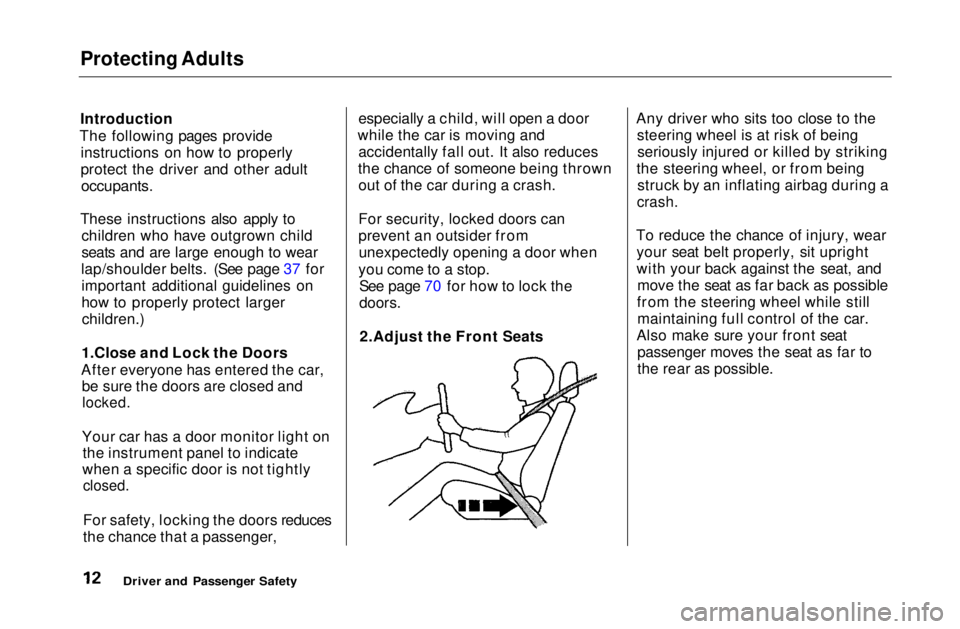
Protecting Adults
Introduction
The following pages provide instructions on how to properly
protect the driver and other adult
occupants.
These instructions also apply to children who have outgrown child
seats and are large enough to wear
lap/shoulder belts. (See page 37 for important additional guidelines on
how to properly protect largerchildren.)
1.Close and Lock the Doors
After everyone has entered the car, be sure the doors are closed and
locked.
Your car has a door monitor light on the instrument panel to indicate
when a specific door is not tightly
closed.
For safety, locking the doors reduces
the chance that a passenger, especially a child, will open a door
while the car is moving and accidentally fall out. It also reduces
the chance of someone being thrown out of the car during a crash.
For security, locked doors can
prevent an outsider fromunexpectedly opening a door when
you come to a stop. See page 70 for how to lock the
doors.
2.Adjust the Front Seats Any driver who sits too close to the
steering wheel is at risk of beingseriously injured or killed by striking
the steering wheel, or from being struck by an inflating airbag during a
crash.
To reduce the chance of injury, wear your seat belt properly, sit upright
with your back against the seat, and move the seat as far back as possible
from the steering wheel while still maintaining full control of the car.
Also make sure your front seat passenger moves the seat as far to
the rear as possible.
Driver and Passenger SafetyMain Menu Table of Contents s t
Page 16 of 269
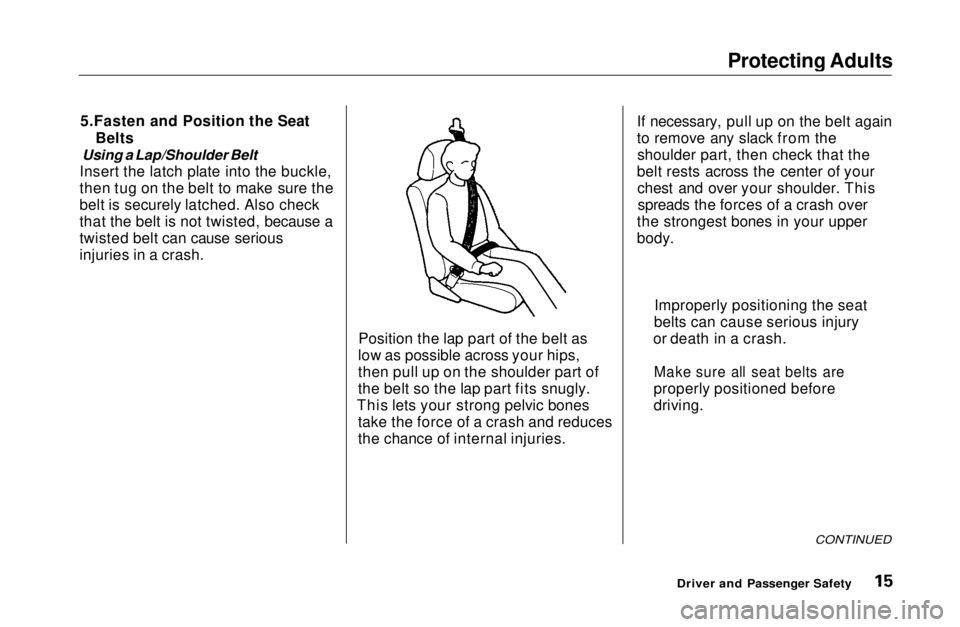
Protecting Adults
5.Fasten and Position the Seat Belts
Using a Lap/Shoulder Belt
Insert the latch plate into the buckle,
then tug on the belt to make sure the
belt is securely latched. Also check
that the belt is not twisted, because a
twisted belt can cause serious
injuries in a crash.
Position the lap part of the belt as
low as possible across your hips,
then pull up on the shoulder part of
the belt so the lap part fits snugly.
This lets your strong pelvic bones take the force of a crash and reduces
the chance of internal injuries. If necessary, pull up on the belt again
to remove any slack from the
shoulder part, then check that the
belt rests across the center of your chest and over your shoulder. Thisspreads the forces of a crash over
the strongest bones in your upper
body.
CONTINUED
Driver and Passenger Safety
Improperly positioning the seat
belts can cause serious injury
or death in a crash.
Make sure all seat belts are
properly positioned before
driving.Main Menu Table of Contents s t
Page 17 of 269
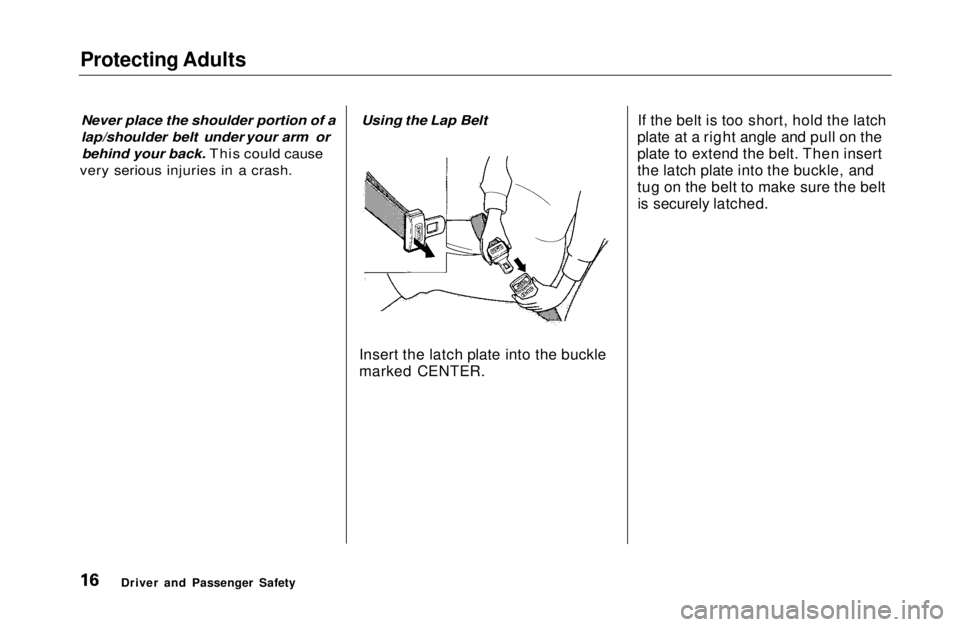
Protecting Adults
Never place the shoulder portion of a
lap/shoulder belt under your arm orbehind your back. This could cause
very serious injuries in a crash. Using the Lap Belt
Insert the latch plate into the buckle
marked CENTER. If the belt is too short, hold the latch
plate at a right angle and pull on the
plate to extend the belt. Then insert
the latch plate into the buckle, and
tug on the belt to make sure the belt is securely latched.
Driver and Passenger SafetyMain Menu Table of Contents s t
Page 24 of 269
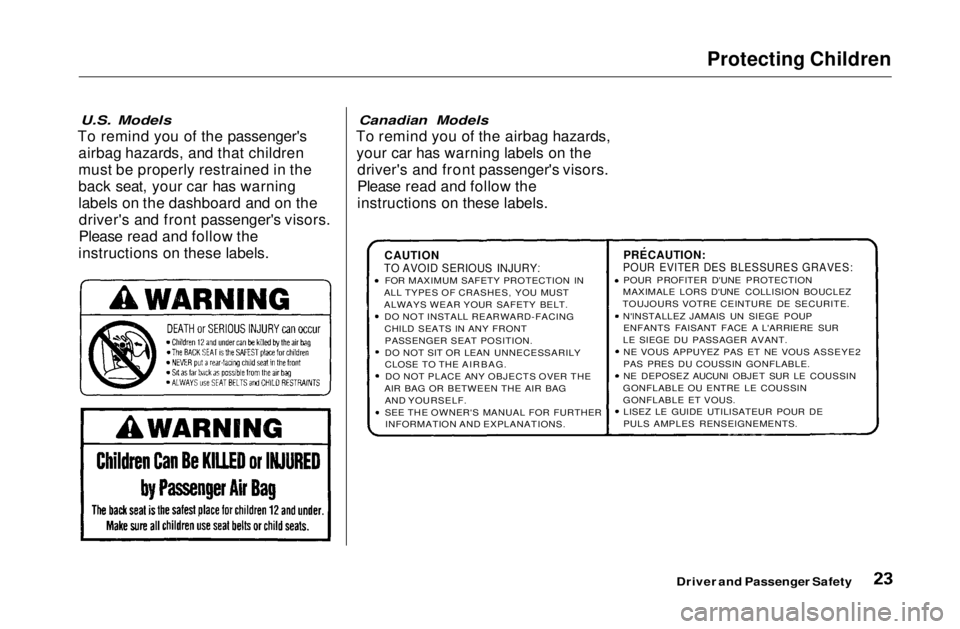
Protecting Children
U.S. Models
To remind you of the passenger's airbag hazards, and that children
must be properly restrained in the
back seat, your car has warning
labels on the dashboard and on thedriver's and front passenger's visors.
Please read and follow the
instructions on these labels.
Canadian Models
To remind you of the airbag hazards, your car has warning labels on the driver's and front passenger's visors.
Please read and follow the
instructions on these labels.
Driver and Passenger Safety
CAUTION
TO AVOID SERIOUS INJURY.
FOR MAXIMUM SAFETY PROTECTION IN
ALL TYPES OF CRASHES, YOU MUST
ALWAYS WEAR YOUR SAFETY BELT. DO NOT INSTALL REARWARD-FACING
CHILD SEATS IN ANY FRONTPASSENGER SEAT POSITION.
DO NOT SIT OR LEAN UNNECESSARILY
CLOSE TO THE AIRBAG.DO NOT PLACE ANY OBJECTS OVER THE
AIR BAG OR BETWEEN THE AIR BAG AND YOURSELF.
SEE THE OWNER'S MANUAL FOR FURTHERINFORMATION AND EXPLANATIONS.
PRECAUTION:
POUR EVITER DES BLESSURES GRAVES:
POUR PROFITER D'UNE PROTECTION
MAXIMALE LORS D'UNE COLLISION BOUCLEZ
TOUJOURS VOTRE CEINTURE DE SECURITE.
N'lNSTALLEZ JAMAIS UN SIEGE POUPENFANTS FAISANT FACE A L'ARRIERE SUR
LE SIEGE DU PASSAGER AVANT. NE VOUS APPUYEZ PAS ET NE VOUS ASSEYE2
PAS PRES DU COUSSIN GONFLABLE.
NE DEPOSEZ AUCUNI OBJET SUR LE COUSSIN
GONFLABLE OU ENTRE LE COUSSIN
GONFLABLE ET VOUS. LISEZ LE GUIDE UTILISATEUR POUR DE
PULS AMPLES RENSEIGNEMENTS.Main Menu Table of Contents s t
Page 25 of 269
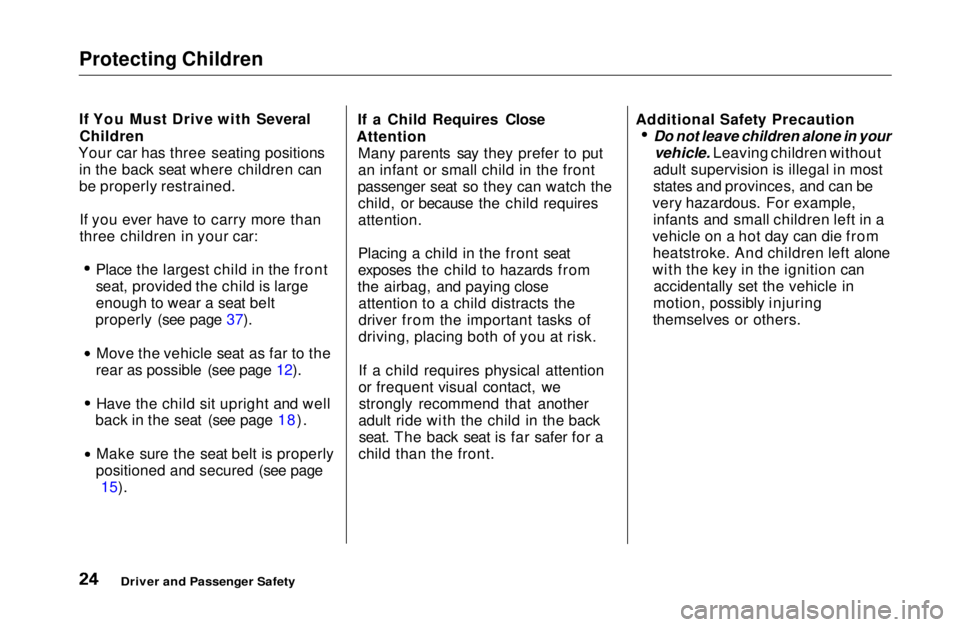
Protecting Children
If You Must Drive with Several
Children
Your car has three seating positions in the back seat where children can
be properly restrained.
If you ever have to carry more than
three children in your car: Place the largest child in the front
seat, provided the child is large
enough to wear a seat belt
properly (see page 37). Move the vehicle seat as far to the
rear as possible (see page 12). Have the child sit upright and well
back in the seat (see page 18). Make sure the seat belt is properly
positioned and secured (see page 15). If a Child Requires Close
Attention Many parents say they prefer to put
an infant or small child in the front
passenger seat so they can watch the child, or because the child requires
attention.
Placing a child in the front seat
exposes the child to hazards from
the airbag, and paying close attention to a child distracts the
driver from the important tasks of
driving, placing both of you at risk.
If a child requires physical attention
or frequent visual contact, westrongly recommend that another
adult ride with the child in the back seat. The back seat is far safer for a
child than the front. Additional Safety Precaution
Do not leave children alone in your
vehicle. Leaving children without
adult supervision is illegal in most
states and provinces, and can be
very hazardous. For example, infants and small children left in a
vehicle on a hot day can die from heatstroke. And children left alone
with the key in the ignition can accidentally set the vehicle in
motion, possibly injuring
themselves or others.
Driver and Passenger SafetyMain Menu Table of Contents s t
Page 28 of 269
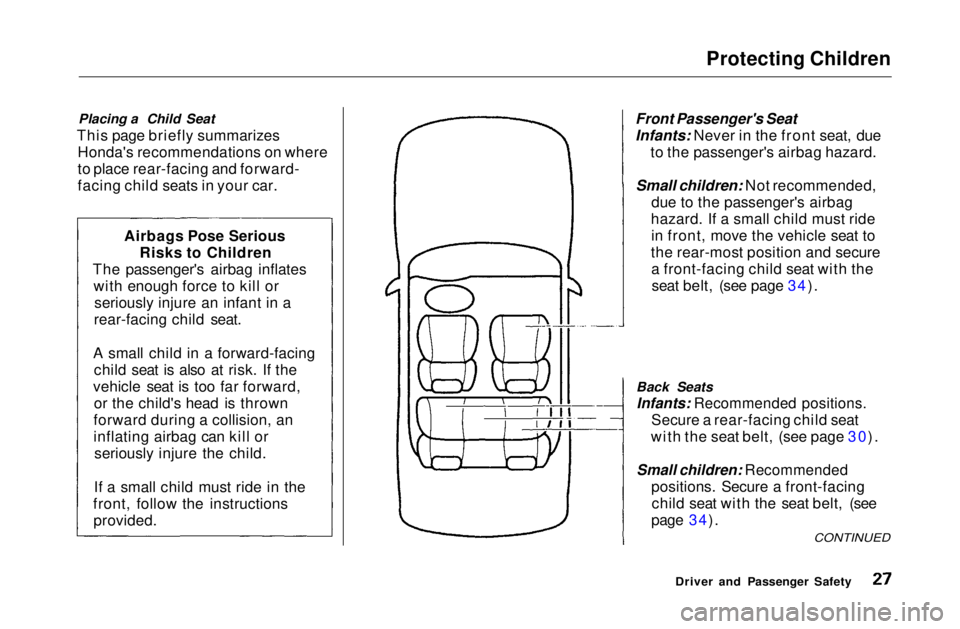
Protecting Children
Placing a Child Seat
This page briefly summarizes Honda's recommendations on where
to place rear-facing and forward-
facing child seats in your car.
Front Passenger's Seat
Infants: Never in the front seat, due
to the passenger's airbag hazard.
Small children: Not recommended,
due to the passenger's airbag
hazard. If a small child must ride in front, move the vehicle seat to
the rear-most position and secure a front-facing child seat with theseat belt, (see page 34).
Back Seats
Infants: Recommended positions.
Secure a rear-facing child seat
with the seat belt, (see page 30).
Small children: Recommended
positions. Secure a front-facingchild seat with the seat belt, (see
page 34).
Driver and Passenger Safety
Airbags Pose Serious
Risks to Children
The passenger's airbag inflates with enough force to kill orseriously injure an infant in a
rear-facing child seat.
A small child in a forward-facing child seat is also at risk. If the
vehicle seat is too far forward, or the child's head is thrown
forward during a collision, an
inflating airbag can kill or seriously injure the child.
If a small child must ride in the
front, follow the instructions provided.
CONTINUEDMain Menu Table of Contents s t
Page 29 of 269
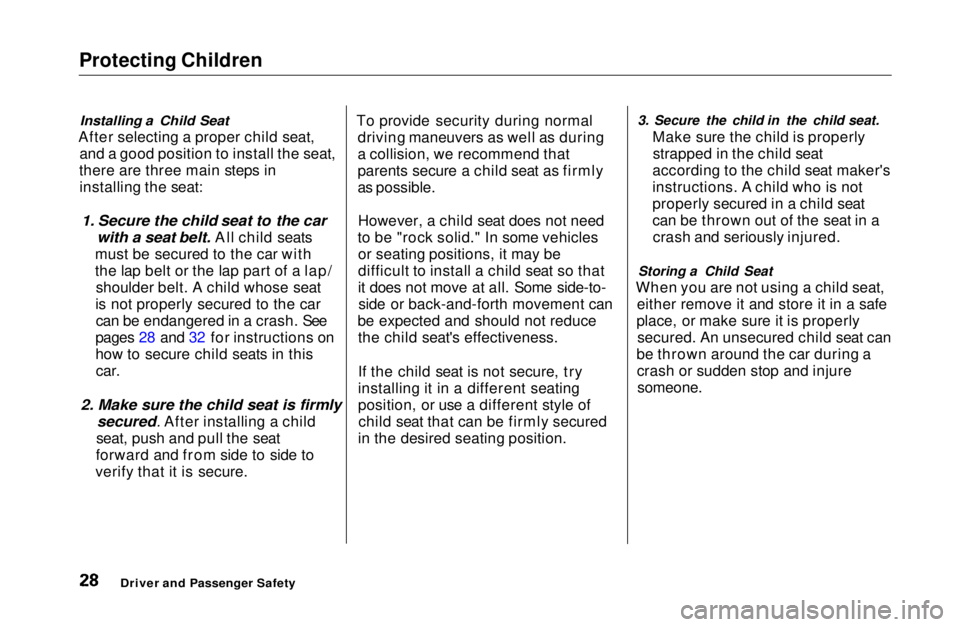
Protecting Children
Installing a Child Seat
After selecting a proper child seat, and a good position to install the seat,
there are three main steps in installing the seat:1. Secure the child seat to the car
with a seat belt.
All child seats
must be
secured to the car with
the lap belt or the lap part of a lap/ shoulder belt. A child whose seat
is not properly secured to the car can be endangered in a crash. See
pages 28 and 32 for instructions on
how to secure child seats in this car.
2. Make sure the child seat is firmly
secured
.. After installing a child
seat, pus h
and pull the seat
forward and from side to side to
verify that it is secure. To provide security during normal
driving maneuvers as well as during
a collision, we recommend that
parents secure a child seat as firmly
as possible.
However, a child seat does not need
to be "rock solid." In some vehicles or seating positions, it may be
difficult to install a child seat so that
it does not move at all. Some side-to-side or back-and-forth movement can
be expected and should not reduce the child seat's effectiveness.
If the child seat is not secure, try
installing it in a different seating
position, or use a different style ofchild seat that can be firmly secured
in the desired seating position. 3. Secure the child in the child seat.
Make sure the child is properlystrapped in the child seat
according to the child seat maker's
instructions. A child who is not
properly secured in a child seat
can be thrown out of the seat in a crash and seriously injured.
Storing a Child Seat
When you are not using a child seat, either remove it and store it in a safe
place, or make sure it is properly secured. An unsecured child seat can
be thrown around the car during a crash or sudden stop and injure
someone.
Driver and Passenger SafetyMain Menu Table of Contents s t